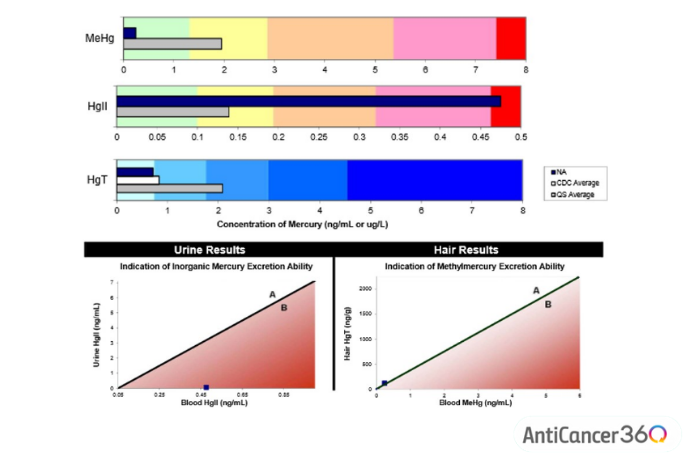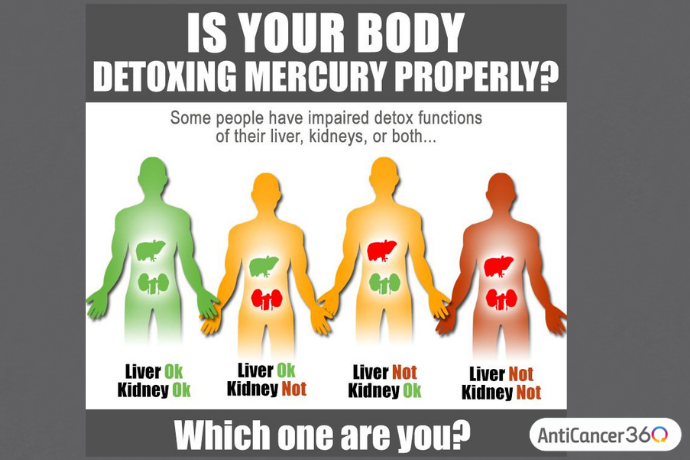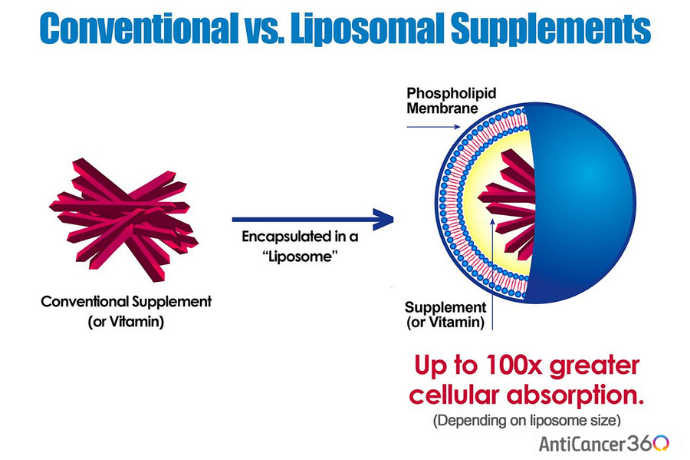Don’t have time to read? Here’s a quick summary:
- To promote detoxification in your body, you can either do an advanced nutraceutical based detox program, or a DIY kitchen based detox program. But, you may benefit more from an advanced detox program if you are suffering from chronic illness, work in a toxic environment, or have a known case of toxicity.
- The advanced detox program we use was designed for mercury toxicity. But it applies to all toxins because of the detox mechanisms that it targets.
- Standard blood mercury tests are only useful in very limited situation (i.e. severe mercury toxicity from fish consumption.) Urine provocation and hair tests are also limited in their usefulness.
- The best option for mercury toxicity testing is a “Mercury Tri-Test” which tests hair, urine, and blood (with high sensitivity.) It also gives you an idea of where the mercury came from, how well your liver detoxification mechanisms are working, and how well your kidney detoxification mechanisms are working.
- Some of the natural detox substances used in a nutraceutical based program can be gotten in food (with significant effort.) But for other substances, this is unrealistic.
- For some people, the mechanisms that turn your nutrients into your body’s detox chemicals may not be working very well.
- Advanced supplement formulations can also increase nutrient delivery into your cells… even up to 100x greater than basic formulations.
- Absorption of nutrients is key, especially if you have problems with absorption due to gut issues.
- People with a history of mold exposure may also need additional help, to eliminate potential “epigenetic” blockages of their detoxification system.
- So… consider all of these things when you are deciding whether to do a DIY kitchen based detox program, or an advanced nutraceutical based detox program.
Optimizing your body’s detoxification system is one of the most important factors for healthy living.
But there are many different techniques that you can use, and different levels to which you can detoxify your body.
If you’re generally a healthy person, and just want to support your body’s detox abilities, take a look at:
How To Do A Kitchen Based Detox Program: The Ultimate Guide
There I explain step by step how to do a “Kitchen Based Detox Program” with things that you can find at the grocery store. In fact, this program mimics the advanced detox program that we’ll be explaining in this article.
Though a DIY detox program is beneficial, there are also those cases in which you’d want to opt for an advanced, nutraceutical based detox program.
Whether you have a ongoing chronic condition, or work in a toxic environment, you may need more detoxification support than you can get from a kitchen based detox program.
For these types of cases we use a program designed by Chris Shade PhD, of Quicksilver Scientific… which in our opinion, in the leader in detoxification science, and advanced detox protocols.
And while you CAN mimic a lot of these techniques by including certain foods in your diet, there are still going to be some major differences.
So in this guide, we’re going to talk about:
- How an advanced detox program like this works
- How it differs from a kitchen based detox program
- When you should choose one over another.
(If you’re interested in some of the science behind this program, here’s one of Dr. Shades presentations that you can watch also.)
Mercury Detox… Overall Detox
As their name suggests, the Quicksilver Scientific detoxification program was designed to target mercury toxicity. Mercury has become a common problem because of its prevalence in mercury amalgam dental fillings. But another major source of exposure is from eating certain types of fish too often.

Though not as significant for most people, other sources of mercury exposure include certain cosmetic products (skin whiteners), vaccines that contain thimerosal, and air pollution for coal burning power plants.
Though the Quicksilver Scientific detox program was designed with mercury in mind, it also supports the whole body’s detoxification systems overall. Though there are some differences depending on the individual toxin, your body processes all toxic substances with the same detoxification system.
In other words, if you support mercury detoxification, you’ll also be supporting detoxification of all the other other toxins that you may have in your body.
Quicksilver Mercury Tri-Test vs. Other Mercury Tests
But if you suspect that you have problem with mercury toxicity, the Quicksilver Scientific Mercury Tri-Test has some very important differences from traditional mercury toxicity tests.

Unlike traditional tests, the Quicksilver Tri-Test detects the different types of mercury in the blood… both methylmercury and inorganic mercury.
Methylmercury mostly comes from eating fish.
Inorganic mercury mostly comes from mercury amalgam dental fillings.
Traditional blood tests really only show you the levels methylmercury in the blood (i.e. from fish sources.) The reason? Because the amount of methylmercury found in blood is usually much greater than that of inorganic mercury (usually 10x more). So the methylmercury basically “clouds” the results.
(As you’ll see later, this is also why mercury toxicity from dental fillings has been historically hard to detect.)
Hair tests also only show you how much methylmercury is being eliminated by your body. But if your liver isn’t doing a great job of this, the hair might not show anything even if there is mercury in your body [1].
A “urine provocation test” on the other hand, can show you how much inorganic mercury (i.e. mostly from dental fillings) is coming out of the urine… But… there are some major problems with this also.
Urine provocation tests use “chelating agents” to bind and pull the mercury out of your cells, so that you can eliminate it. Because of this, you can then measure the mercury levels eliminated through the urine.
However… if you’re kidneys aren’t eliminating the mercury well, you won’t find much of it in the urine after provocation (see example below). And because kidney detoxification happens in the “proximal tubules” (not the glomeruli) a standard kidney function test that you’d get at the hospital wouldn’t give you any warning.
Another problem with this type of a test is that it can cause the mercury to be “redistributed” to different areas of the body. In other words, if you’re detox systems aren’t working well, you might be “stirring up” the toxins without eliminating them. In some cases, this can cause more even more issues, especially if the mercury is redistributed to the brain.
Mercury Overlooked By Other Tests
Here’s an example of a Quicksilver Mercury Tri-Test showing how both a standard blood test, and a urine provocation test can fail to show mercury toxicity… even when the person’s mercury levels are off the charts.

If you look at MeHg (methylmercury) levels, you’ll see that the Tri-test result doesn’t show much at all… less than .5 ng/ml.
A conventional mercury test is only sensitive to about .5 ng/ml at best (more like 1-1.5 ng/ml in most cases). So if this person would have gotten a standard mercury test from the hospital (or a lab like Quest or Labcorp)… They wouldn’t see any mercury at all.
But when you look at HgII (inorganic mercury from mercury fillings)… you’ll see that it’s off the charts using the Quicksilver Tri-Test (near .5 ng/ml). In this case, being close to .5 ng/ml is a VERY high burden of inorganic mercury because we’re talking about inorganic mercury, rather than methylmercury.
But again, because .5 ng/ml is as low as they can go (at best), a conventional mercury test wouldn’t have detected this problem at all.
Beyond this… a urine provocation test wouldn’t have shown anything either.
Take a look at the urine results…
You’ll see that the inorganic mercury is NOT coming out of the urine in this case… even though the blood levels are off the charts. This is a case where the kidneys aren’t doing their job of expelling the mercury.
So in a single case example, you can see how a standard blood test, and urine provocation test can both fail to detect mercury toxicity (even when the levels are very high).
Testing Blood, Hair, And Urine
As you can see, there are many details when it comes to mercury toxicity testing. Because of this, the Quicksilver Scientific developed their “Mercury Tri-Test” which mercury in the blood, urine, and hair.
Comparing the mercury levels in the blood vs hair, gives you an idea of how well your liver is eliminating mercury via the stool [2]. In this case, the mercury is sent from the liver, into the gallbladder via bile (the chemical that makes your stools green), then into the small intestines to be sent out in the stool.
And as you saw from the previous example, comparing the mercury levels in the blood vs urine tells you how well your kidneys are expelling the mercury.

So testing the mercury from all 3 of these angles gives you a complete picture of how well you’re detoxifying yourself of mercury. It can also help you find the potential cause of any mercury retention (i.e. whether it’s your kidneys, or your liver/gallbladder/intestinal complex that isn’t detoxing so well.)
Without the Quicksilver Tri-Test there’s no way to get any of this information. You’d essentially be stabbing in the dark… And knowing these things about your condition is important for designing an optimized detox program.
Targeted Detoxification
So based on the information that you get from the Quicksilver Tri-Test, you can target a detoxification program to better suite your situation.
Some people may need more support with their kidney detox function… other’s with their liver function. Some people may have an inflammatory bowel disorder that is the underlying issues… for another person, it may be a gallbladder issue.
The Quicksilver Tri-Test gives you an overall idea, and the best starting point to address these issues.
Specific Detox Chemicals, High Potency, and Cellular Absorption
So much like the advancements that Quicksilver Scientific has made with mercury testing… they have also done the same with detoxification programs.
And based on this advanced knowledge of detoxification, I also wanted to show you how to detox yourself by mimicking the Quicksilver detox program using common food ingredients.
But… there are going to be some major difference, and situations in which you’d want to use a nutraceutical based detox program instead.
In our Ultimate Guide, we explained all the different phases of detoxification, and how you can support them with certain foods. But as you will see there are also certain detox chemicals that you can’t get from food in a high enough concentration.
Alpha lipoic acid for example, is one of the most potent detox nutrients… and you only get very small amounts from food. It’s been estimated that a common dose of supplemental Alpha Lipoic would give you 1000x greater amounts than you could get from diet [3]. And this doesn’t take into account the advanced nutrient delivery systems that we’ll talk about later.
The second issue is the overall concentration of the detox nutrients you get in food, compared to nutraceuticals.
For an aggressive detoxification, the daily dose of polyphenols in nutraceutical form is about 3600 mg per day, in addition to what you get from your diet. And in order to get this amount of polyphenols from food, it would take quite a bit of food.
Here are some examples of how much you’d need of a certain food to give you 3,600 mg of polyphenols.

So as you can see, it is doable to get this level of polyphenols you need from food. But you’d basically have to dedicate your entire diet to the foods richest in polyphenols.
Beyond this, there are many different types of polyphenols, each with their own unique functions. Each food and/or herb will include a specific set of polyphenols.
And some of these polyphenols and phytochemicals may promote detox better than others [4]. So depending on the foods that you end up including in your detox diet, you may or may not be getting enough of the most important ones.
Food Sources May Not Be Enough
Another potential issue is your body’s production of glutathione. Glutathione is your body’s master antioxidant, and one of the most critical components of detoxification.
While you can support glutathione production by giving your body the precursor nutrients (as with a kitchen based detox)… there are cases where you would want to take the glutathione itself, rather than the precursor nutrients.
People with inflammatory bowel issues for example, may have decreased activity of glutathione related enzymes in the intestines [5].
A variety of neurological disorders are also associated with problems in glutathione synthesis, and reduced levels of glutathione in certain areas in the body [6].
Some people may have genetic mutations that lower their ability to make glutathione, which could also contribute to a variety of diseases [7].
In these types of cases, your body may not be able to make enough glutathione where you need it the most. Thus, an advanced detox program with supplemental glutathione may be the best option.
The Right Type Of Glutathione Is Key
In cases where you’d want to supplement directly with glutathione, using the right type of glutathione is also key.
Standard glutathione supplements aren’t very useful because they are quickly destroyed by the digestion process. Even IV glutathione has issues with absorption into the cells, and it’s quickly oxidized [8].
Because of this, the best option is to get a “liposomal” form of glutathione. This type of formula uses liposomes to carry glutathione (and any other nutrient/ natural compound or drug) rapidly into the cells.
A liposome basically encapsulates a nutrient with the same material that makes up your cell membranes (phosphatidylcholine). This allows it to pass right into the cell.
This is especially important with glutathione because your cells don’t have transporters to pull in glutathione effectively.
In fact, a good liposomal from of glutathione may be up to 100 time more potent than even IV glutathione [9]. It’s also alot less expensive than IV glutathione therapy.
Liposome Size: A Critical Factor
Within the last few years, liposomal supplements have become very popular. But even liposomal supplements come in different grades/ qualities.
This is another area where Quicksilver Scientific has made some great advancements. They’ve essentially developed nutraceuticals with a level of liposome technology that was only available to pharmaceutical companies.
Liposomes come in many different levels of quality, and liposome sizing. But the key to optimal absorption is have having very small and consistent liposomes.
Lab analyses have shown that very small liposomes can absorb into cells over 30x better than large liposomes, let alone non-liposomal formulations (potentially up to 100X more than these).
In fact, you can see the quality of any given liposomal formula just by looking at it. If the formula is milky and thick, it’s of the lowest quality of liposomes (400-1200 nanometers in size). If it’s milky and thin, it’s of a medium quality (200-300 nanometers).
The highest quality liposomal formulas are thin and clear (around 100 nanometers).
The average liposome size of the supplements we use is 64 nanometers.
So what’s the difference? The difference in absorption of 64 nanometer liposome is estimated to be 34 times greater than a 240 nanometer liposome.

So to get maximum absorption of any detox nutrient into your cells, a high quality liposomal formula is best.
The science behind liposomes also sheds light on the difference in quality you can get between two supplements of the same name. Even two “ liposomal glutathione supplements” can be very different, let alone a “general glutathione supplement”.
Knowing this is key to choosing the best supplements, and getting the best results.
Your Gut May Not Be Absorbing
Another potential limitation with a kitchen based detox program is how much of these nutrients are absorbed in the gut.
Much like with glutathione formation problems, various problems in the gut can cause malabsorption. This includes disorders like Celiac disease [10], Chron’s disease [11], small intestine bacterial overgrowth (SIBO), and malabsorption caused by a previous infection in the gut [12].
These types of issues can reduce your overall nutrient absorption from your food. This can also cause absorption problems with the various detox nutrients that come from food.
The main solution to this are the liposome based supplements that we discussed earlier. The phosphatidylcholine that surrounds the nutrient in a liposomal formulation allow it to bypass digestion and absorb directly into the the blood stream. This is also the same characteristic that allows it to pass into your cells so effectively.
Aside from it’s ability to transport nutrients, phosphatidylcholine itself can also be important for repairing cell membranes… especially in people with digestive issues.
The fats in a (pure) phosphatidylcholine supplement (not lecithin) can bypass digestion, and go straight into repairing cell membranes. This may be especially important for aging and diseased cells [13].
In this case, taking pure phosphatidylcholine bypasses the need for the body “reassemble” phosphatidylcholine from digested components (as would occur with a lecithin supplement.)
Overall, supporting cell membranes health is important for Phase 3 detoxification. This where your cells actually pump the toxins out of the cells using transporters called “MDR transporters.”
This same process also allows your cells to pump the toxins out of the body via the liver and kidneys.
NRF2 Blockages
Another common issue that can require supplementation is with “epigenetic blockades” of Nrf2. When this happens Nrf2 (a critical detox mechanism) basically gets turned off.
The most common cause is mold exposure [14]… but it could also occur because of cancer [15], and possibly even chronic viral infection (this hasn’t been proven yet, but seems likely from clinical knowledge.)
A common manifestation of this Nrf2 blockade is multiple chemical sensitivity. This can also make you sensitive to some of the nutrients that you would usually use for detoxification itself.
So before you can detox properly, you’ll want to turn Nrf2 back on.
From what we know currently, the best way to do this is with a natural compound called “Diindolylmethane” (DIM). Without taking DIM first, some people will feel worse while doing a detox program, or will just “crash” over and over again throughout the program.
In this type of situation, you’re trying to stimulate a detox mechanism that has been “turned off” by an epigenetic switch.
Though you can get DIM indirectly from food sources (cruciferous vegetables), relying on food sources probably won’t be enough.
Though it’s difficult to compare the DIM in food, to a nano-liposomal DIM… Let’s look at this a bit closer.
Keep in mind that before nano-liposomal DIM was ever available, we used a “high absorption DIM” at a dose of 200mg per day.
But in a nano-liposomal from, we now only need to use up to 60 mg per day to support a detox program. This would be equivalent to about 2 cups of broccoli (indirectly from Indole-3-Carbinol [16].)
At first glance, this sounds easily doable. However, 60 mg of DIM in a nano-liposomal is very different from a 60 mg of DIM overall.
Because of DIM’s chemical makeup, it’s difficult to get it into the body and into the cells. In general, it’s known to be a low bioavailability nutrient [17].
But when you deliver the DIM in these extra small liposomes, it could easily mean a 90 fold increase in delivery into the cell compared to a non liposomal DIM formulation [18],[19].
So as an estimate, you would need about 180 cups of or 36 lbs broccoli to accomplish this task…

There are a few other problems with getting DIM from food…
Cruciferous vegetables like broccoli supply your body with a DIM precursor called “Indole-3-Carbinol” (I3C). This relies on stomach acid to convert to DIM.
But if you have low stomach acid production for example, it can lower the amount of IC3 that will get converted to DIM. And as we mentioned before, if there are any inflammatory issues in your gut, absorption can be further decreased.
Using a nano-liposome delivery will bypass all of these things, allowing the DIM to go directly into the bloodstream right from the blood vessels under your tongue. The same mechanisms that allow this high rate absorption also let’s it get into your cells efficiently.
Maintaining Detox VS Accelerating Detox
Perhaps the most important thing to consider is whether you want to correct and maintain detoxification in the body… or if you want to correct and accelerate detoxification.
And besides the Nrf2 blockages that we talked about earlier, the biggest factor in maintaining vs accelerated detox is how MUCH of these detox nutrients you get into the body.
Overall, if you want to turn up your detox pathways to work at a high pace, higher doses of these detox nutrients are necessary.
In fact, you can get these detox system to work at 200-300% over baseline with the right doses [20].
Lower doses on the other hand will mostly just work to get you back up to baseline, if your body’s detox abilities are low.
Conclusion
So if you are trying to figure out whether you should do a “kitchen based detox” or an advanced detox program… here are the 3 main things you’ll want to think about:
- How toxic is my workplace/ environment?
- How healthy is my digestive system?
- Do I have any concurrent health conditions?
If you’re pretty healthy overall, and work in a minimally toxic environment, then you can just a kitchen based detox to get your detox system back into shape.
But if you work in a toxic environment (i.e. nail salon, around airplanes, construction, auto shops, etc..), and/ or you have a concurrent health condition, then you should consider an advanced detoxification program.
Do you want to start with an advanced detoxification program? Click here to contact us today.
Are You A Candidate For Our Program?
If you’d like to learn more about the AntiCancer360 approach and see if we can help you… please watch our free online webinar to learn more about our approach. Then at the end, you’ll be able to schedule a free call with someone from our team so that we can discuss your case in more detail.
Gene Wei is a Board Certified Doctor of Oriental Medicine in the state of Florida, and the founder of AntiCancer360. He’s also a graduate of the University of California Los Angeles, and East West College of Natural Medicine. His practice is focused on integrative and natural anticancer strategies. Over the years, he’s helped many people overcome difficult cancers… including some cases of “terminal cancer” which were able to be reversed with an “Aggressive Integrative Approach.”




